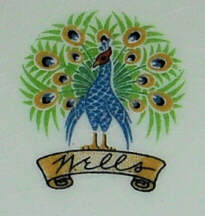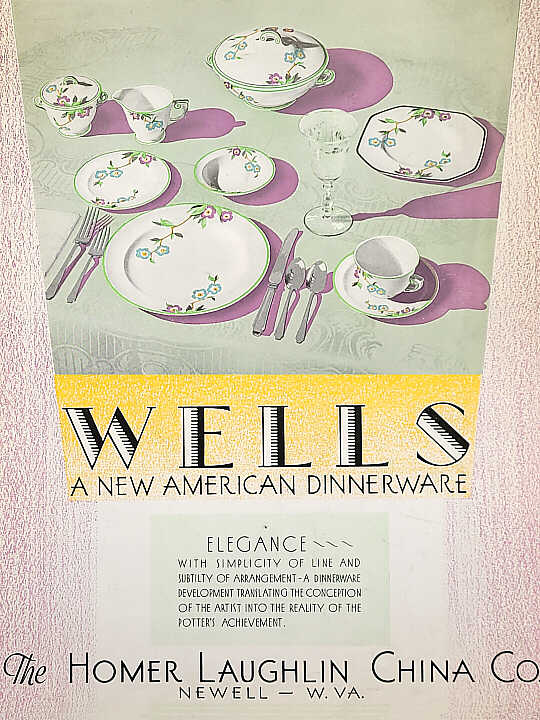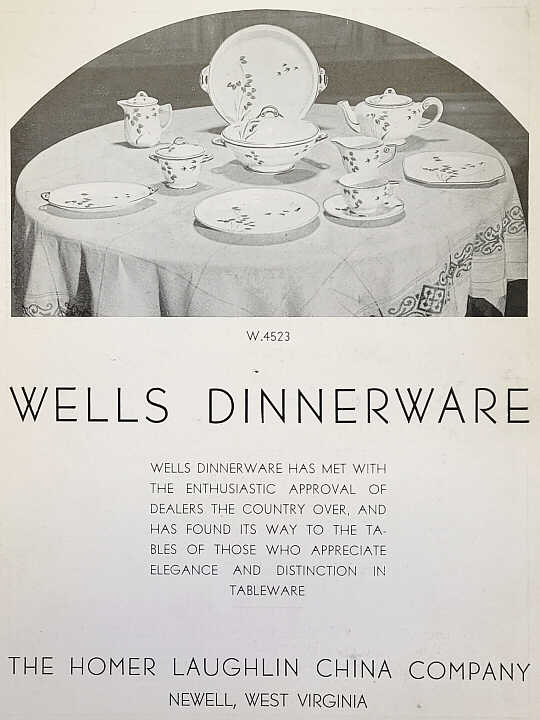 Homer Laughlin introduced the Wells shape in 1930. Hollowware was given applied finials and handles with little scroll decorations and the flatware consisted of plain round rim shapes. These flat piece differed from HLC's other lines such as Empress and Kwaker in that Wells' rim was much more concave and thinner. There is at least one creamer marked Made In Japan that is almost identical to the Wells version. Whether Frederick Rhead created the Wells hollowware based on this import or it if was the other way around isn't certain.
Homer Laughlin introduced the Wells shape in 1930. Hollowware was given applied finials and handles with little scroll decorations and the flatware consisted of plain round rim shapes. These flat piece differed from HLC's other lines such as Empress and Kwaker in that Wells' rim was much more concave and thinner. There is at least one creamer marked Made In Japan that is almost identical to the Wells version. Whether Frederick Rhead created the Wells hollowware based on this import or it if was the other way around isn't certain.
Wells stared out in an ivory body with decals and various sold colors. In early 1931, Rhead made notes in his journals about the Vellum glaze that was under development. In fact, numerous trails of Vellum were made in the then new Century shape as well as Wells. On April 27, 1931 he wrote: "... development in direction of Wells Vellum rather than Century Vellum." However, the vellum glaze would go on to be used more on Century than Wells.
Production of the Wells shape reached a height during the early 1930s. It continued to be made into the mid-1940s, but on a much smaller scale. Originally the assortment was extensive with a demitasse set, cream soups and liners, and muffin covers, but by the end of its run, Wells had been reduced to a much simpler line with only standard flatware and serving pieces.
| Wells trade advertisements from 1930 |
 |
 |
Several Wells items were picked up by other lines. The teapot was used with some Nautilus patterns and the egg cup was used with Swing Eggshell. Lids with restyled finials were made for the teapot and casseroles so they could fit with the Willow shapes and were used with the Fantasy patterns. The teapot was also used with the underglaze Blue Willow line.
Decaled Wells will be marked in one of several ways; a Vellum backstamp, a general HLC marking, or a Wells Peacock mark. Three different peacock marks exist - a multicolored decal, a gold stamp, and a platinum stamp. This is also a case with the Georgian (Craftsman) backstamps and it has been learned that the multicolored mark was used for more expensive patterns and the gold stamp for cheaper ones. The peacock mark can also be found on Century and, to a lesser degree, Jade. Some argue that the peacock mark was used on anything with the Vellum glaze, but this isn't always the case as ivory (a white glaze not to be confused with vellum or Fiesta's old ivory) pieces of Wells can be found with the Wells backstamp. Instead of being a Vellum mark, it seems more likely the marking was used for more "top shelf" treatments - regardless the glaze and shape. The special marking was no longer in used by the mid-1930s.
See also section on Wells Art Glazes.
|